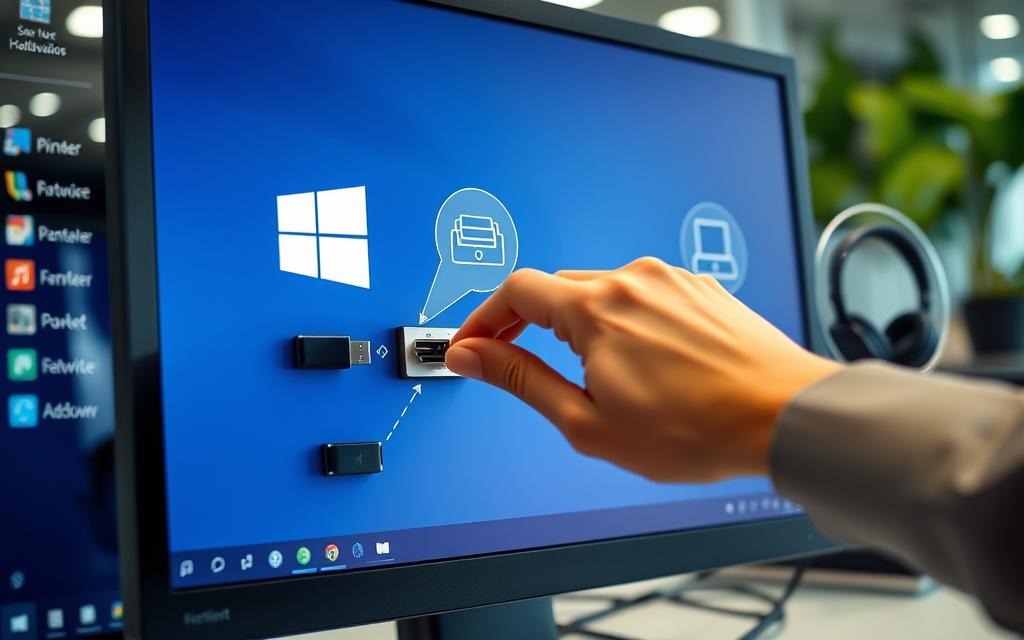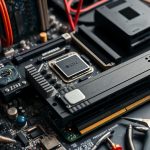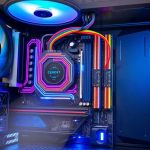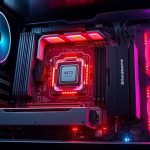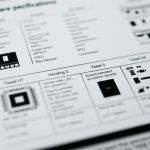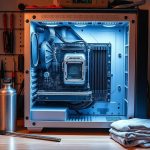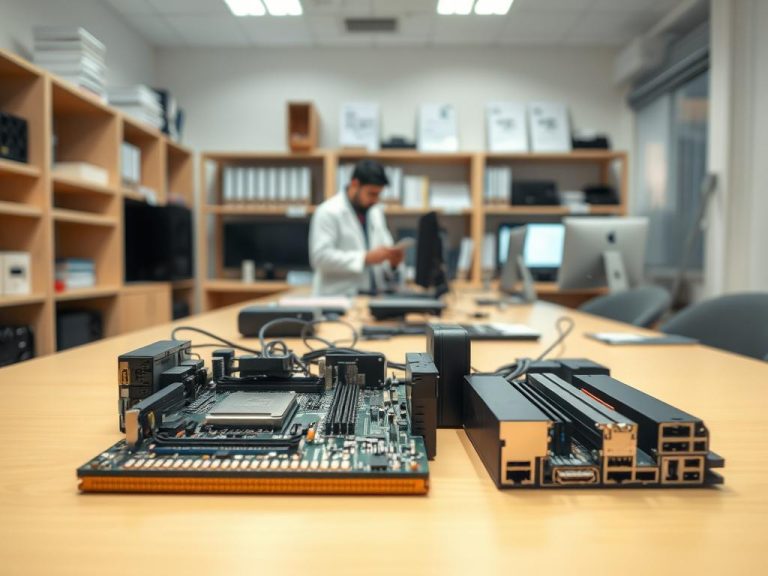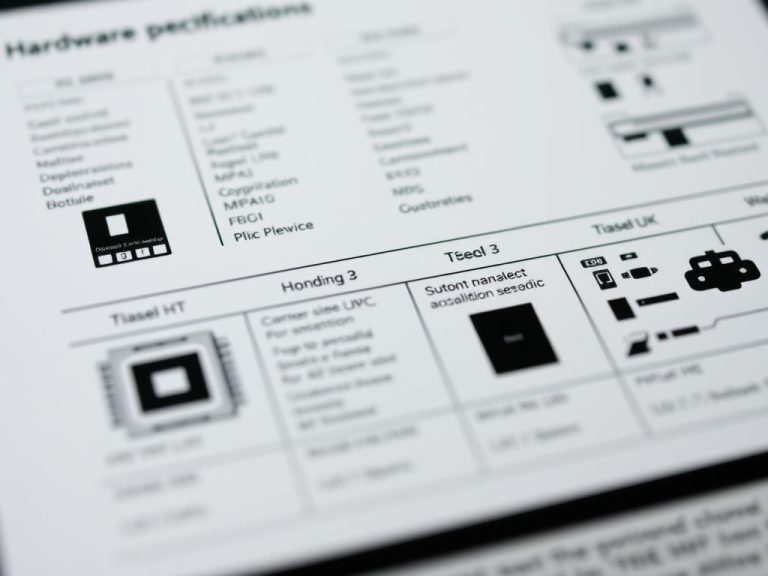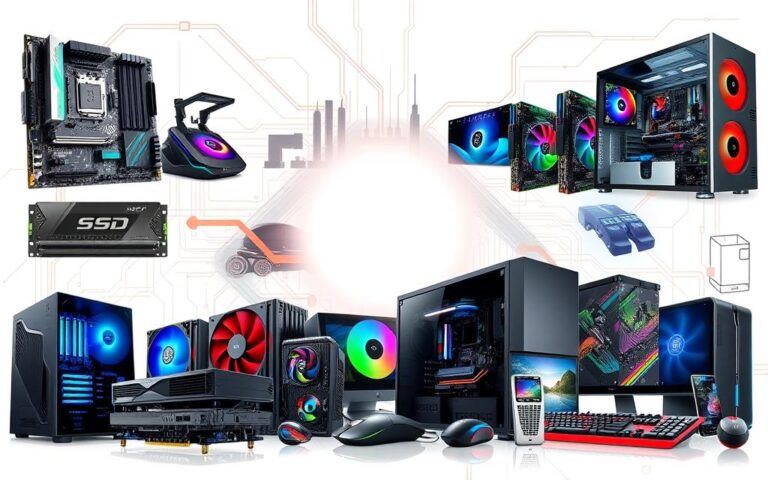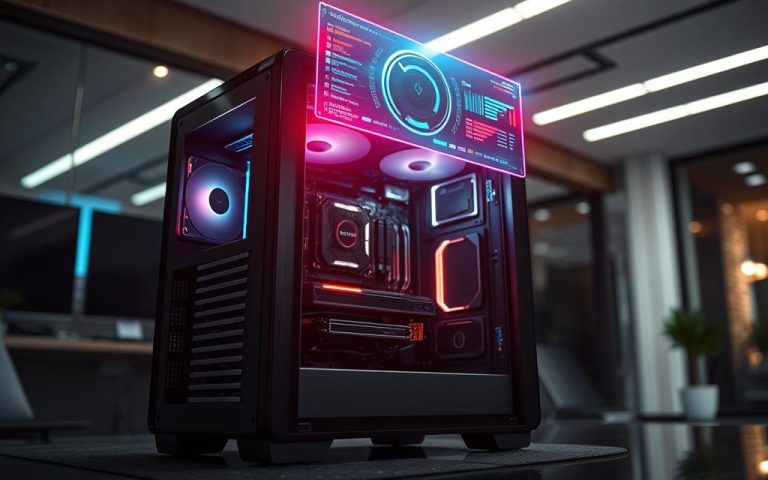Reconnecting Hardware Devices in Windows 11: A Step-by-Step Guide
Reconnecting hardware devices like printers and scanners to a computer with Windows 11 is key. These devices boost productivity. Troubleshooting can often fix issues related to connections, driver conflicts, or power settings. This guide will show how to identify and fix connection problems. We’ll also talk about how updating drivers can improve performance and stability.
Understanding the Importance of Reconnecting Hardware Devices
Reconnecting hardware devices is key to keeping them working right. Devices might disconnect due to loose connections or old drivers. It’s crucial to reconnect them to ensure the system sees all devices. This lets them work as they should.
Maximising Device Functionality
By properly reconnecting devices, you can make them work better. Sometimes, devices give error messages, like code 45. This means Windows doesn’t see the device. Fixing connections and updating drivers can solve these issues. This improves device performance and makes things run smoother.
Resolving Connection Issues
Devices often disconnect, which shows why reconnecting is so important. The problem might be broken registry keys or device faults. Tools like the Hardware and Device Troubleshooter can fix these issues. Reconnecting correctly helps avoid work interruptions.
| Issue | Possible Causes | Recommended Solutions |
|---|---|---|
| Error Code 45 | Outdated drivers, damaged registry keys, faulty hardware | Reinstall drivers, run DISM scan, update Windows |
| Device Not Recognised | Poor connections, broken USB ports, faulty cables | Check connections, replace cables, try different ports |
| Peripheral Not Functioning | Incorrect settings, outdated software | Utilise Device Manager, update system software |
Identifying the Disconnected Hardware Device
To reconnect a device, first identify which one is disconnected. Start by looking for error messages. These might hint at the problem. Also, check the physical connections for issues.
An excellent tool for this is the Device Manager in Windows 11. It shows the status of all devices. This makes finding and fixing problems easier.
Checking for Error Messages
Error messages are clues to spotting a disconnected device. They warn about devices the system can’t recognise or are not working right. Keep an eye on these warnings. They help identify the exact problem.
Using Device Manager to Locate Issues
Device Manager is key for finding out the status of your devices. If a device is shown as disabled or disconnected, there are steps you can take. For example, you can update drivers or troubleshoot right there.
Make sure the Device Manager shows all you need to know about each connection. By looking closely, you can figure out what to do next. This helps fix the issue properly.
| Error Type | Potential Cause | Recommended Action |
|---|---|---|
| Device Not Recognised | Loose or damaged connection | Check cable connections and replace if necessary |
| Device Disabled | Driver issues | Update drivers using Device Manager |
| Connection Timeout | Interference or network issues | Restart the device and check connections |
| Unsupported Device Error | Incompatible hardware | Ensure the device is compatible with the system |
| Other Error Messages | Software conflicts | Run diagnostics through Device Manager or restart the PC |
How to Reconnect Hardware Device to Computer Windows 11
Reconnecting a hardware device to Windows 11 is quite simple with the right steps. Many experience disconnections that can be fixed easily. It’s important to know how USB and Bluetooth connections work. This helps to get devices running smoothly again.
Step-by-Step Reconnection Process
Start with a clear plan to reconnect your hardware. Here’s what you need to do:
- Shut down your computer for a clean start.
- Unplug the device from the USB port or switch off Bluetooth.
- Restart your computer to update its detection ability.
- Reconnect the device properly.
- Test if the device works by checking its settings.
Following these actions should fix most connection problems with devices.
Reconnecting Using USB, Bluetooth, and Other Methods
There are various ways to reconnect devices, each having its own steps:
- USB Connection: Use a direct computer port for USB devices, avoiding USB hubs. This enhances stability and recognition.
- Bluetooth Reconnection Process: Ensure Bluetooth is on and check the device’s battery. Then, reconnect through Bluetooth settings. If issues remain, remove and re-pair the device.
- Additional Connectivity Options: Some devices might reconnect using Wi-Fi Direct or cloud services. Follow the maker’s advice for these methods.
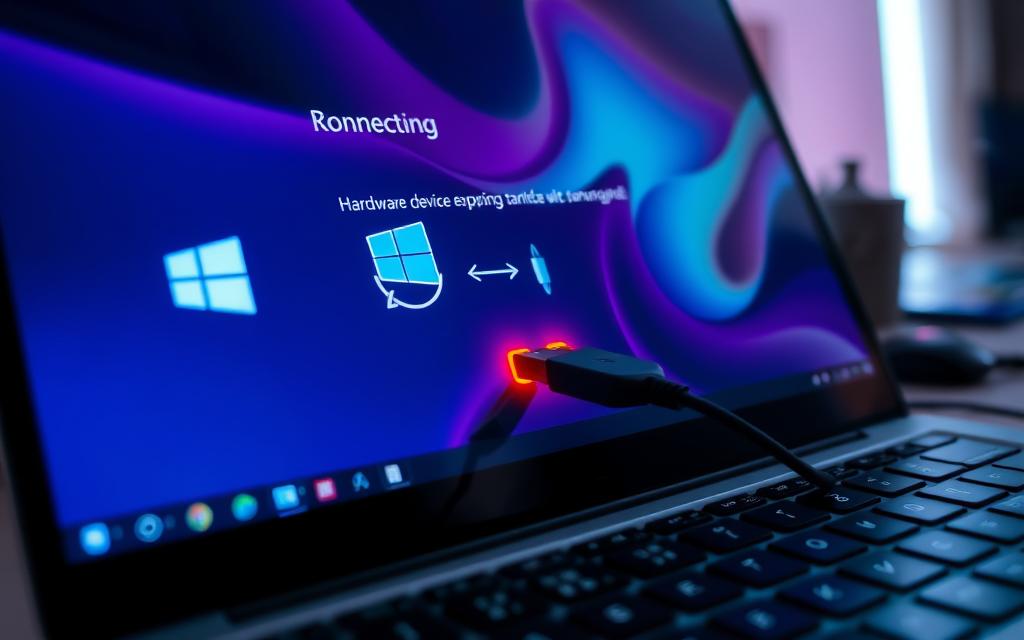
Updating Drivers and Software for Optimal Performance
Keeping your drivers and software up to date is key for making sure hardware devices work well with Windows 11. This not only helps solve compatibility issues but also makes using your device a better experience. Knowing how to find and install updates can make your device more reliable and perform better.
Finding the Latest Drivers
For the best results, it’s important to update your drivers often in Windows 11. The best place to find new drivers is on the manufacturer’s website. There, you can go to the support or downloads area, type in your device model, and get the latest drivers. You could also use tools like Auslogics Driver Updater for an easier update process. This means you don’t have to search different websites to keep your driver in the best shape.
Importance of Software Updates
Software updates are crucial for keeping your drivers working right. Not only do these updates fix bugs, but they might add new features that improve how your system works. Updating software regularly helps avoid problems that old drivers or software can cause. This makes sure your devices keep working with new apps and systems. Windows Update can automatically find and install these updates, which makes keeping your system up to date easier.
Advanced Troubleshooting Techniques
Handling tough hardware problems can be a real headache, especially when usual fixes don’t work. But don’t worry, there are advanced tricks that can help. For example, the Windows built-in Hardware and Devices Troubleshooter is great for spotting and solving many issues without a fuss.
Running the Hardware and Devices Troubleshooter
This tool is a lifesaver for dealing with device troubles quickly. To use it, simply go to Settings, then Update & Security, and click on Troubleshoot. There, you’ll find the Hardware and Devices Troubleshooter. It checks for problems and can fix them automatically.
Dealing with USB Connection Problems
USB issues can come from many places. It’s important to check if the USB ports work well and if your devices are plugged in right. A common issue is the USB Selective Suspend feature causing glitches. Turning this feature off in the device manager settings might help. If you still have issues, try the Hardware and Devices Troubleshooter.
For help with ASUS hardware issues, you can also look at this resource.
| Issue | Potential Solutions |
|---|---|
| Unresponsive USB device | Check connections, restart the device, update drivers. |
| Intermittent connection issues | Disable USB Selective Suspend, try different ports. |
| Device not recognised | Run the Hardware and Devices Troubleshooter, check power settings. |
| Slow data transfer rates | Ensure USB 3.0 ports are used, update drivers. |
Conclusion
This guide has shown you how to troubleshoot and fix connection issues with hardware in Windows 11. We’ve summarised key steps for reconnecting devices, starting with finding the ones that got disconnected.
The journey through this guide emphasises the boost proper hardware connection gives to your computer’s performance. It talks about identifying reasons for disconnection like the ‘Hardware Device Not Connected to the Computer Code 45’ error, and making sure every connection is correctly made. Our recap on troubleshooting points out how crucial up-to-date drivers are for avoiding connection problems.
Learning these techniques allows you to handle your hardware better, ensuring it works smoothly. This leads to less stress and more efficiency in your digital space. By following these tips, your hardware will serve you well, making every task easier and your tech life much happier.
FAQ
What are the benefits of reconnecting hardware devices in Windows 11?
Reconnecting hardware helps them work right by letting the system recognise them again. It fixes any connection issues and allows for driver updates. These updates can boost performance and stop software problems.
How can I identify a disconnected hardware device on my Windows 11 computer?
Look out for error messages and use the Windows Device Manager. This shows the status of all devices. If a device shows as disabled or disconnected, you need to troubleshoot.
What steps should I follow to reconnect my hardware device to Windows 11?
First, turn off your computer and unplug the device. Then restart your computer to reset connections. Finally, reconnect the device. For USB devices, connect them to built-in ports, not to hubs.
How do I ensure my drivers and software are up to date?
Go to the manufacturer’s website for the latest drivers. Updating regularly is key to making sure your device runs well. It solves compatibility issues and improves features.
What should I do if I experience persistent disconnection problems with a USB device?
If USB devices keep disconnecting, try the Hardware and Devices Troubleshooter in Windows. You might also need to turn off USB Selective Suspend in settings. This feature can cause disconnections.
Can reconnecting hardware devices help improve overall productivity?
Yes. Keeping hardware devices properly connected boosts efficiency. It ensures that devices work well without interruptions. This can make you more productive.
